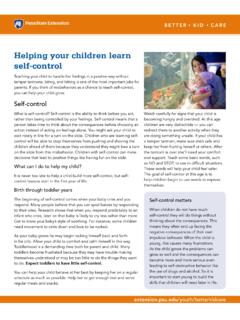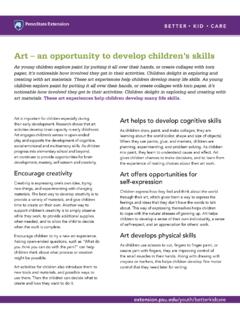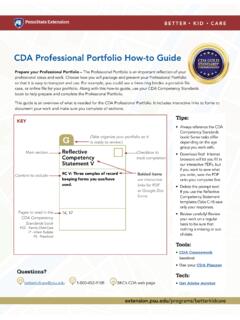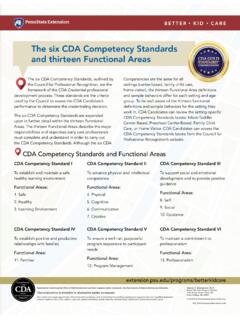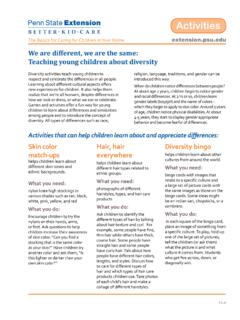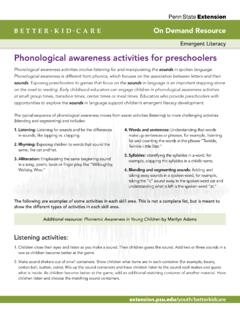Transcription of Scaffolding: Approaches and practices
1 scaffolding : Approaches and practices that scaffolding has undergone significant changes over the years. scaffolding embodies much of the activity that goes on in classroom teaching and teacher-learner interaction. As the metaphor of scaffolding has become popularized, it has often been adopted as a general term that is used to describe all type of support and guidance offered in the classroom. (Boblett 2012). Teachers or peers who are considered expert' or more knowledgeable can provide students with tools needed for learning. Building on prior strengths and knowledge, scaffolding -type experiences assist children in understanding and in forming new connections to learning. For example, an older toddler who was attempting to play with a new set of magnetic blocks became frustrated. In observing the child, the teacher realized that he did not know how to use this type of block.
2 She then showed the toddler that the blocks had a magnetic side that made them stick together and demonstrated how they worked. Helping children achieve goals and deepen learning She encouraged the child to make an attempt: Let's experiences is something early educators think about see if you and I can make these blocks stick together.. often: How can I help each student learn? How can I enrich Through language and social interaction, she modeled the learning experience and help children reach the next how to use the blocks, which in turn helped ease the stage of development? When tasks become challenging, frustration of the toddler and modeled new ideas. The how can I help children find success? scaffolding may teacher did not simply put the blocks together for the child help. Although there is no single definition, scaffolding but rather demonstrated how, along with encouraging the can generally be described as a concept that was first child to try, which helped shift learning to the child.
3 Introduced in child psychology by Wood, Bruner, and Ross (1976): Just as with constructing a building, scaffolding is considered to be temporary. The long term goal is for The intervention of a tutor .. involves a kind of scaffolding ' process that enables a child or novice to solve learners to stand on their own' to transition from a problem, carry out a task or achieve a goal which would assistance to independence. Once children are competent be beyond his unassisted efforts. (p. 90) and able to master more challenging tasks, the scaffolding assistance can be removed. The intention of scaffolding is scaffolding is a technique (or tool) that provides support twofold: it supports learners in accomplishing a task, and it for thinking and learning, typically accomplished through enables them to learn from the experience and hopefully social interactions and language.
4 scaffolding practices carry those skills into future learning. provide the opportunity for children to reach higher-level skills by building on and extending their existing skills. As shared above, scaffolding does not simplify the task, Current research shares various scaffolding theories and but rather presents ways to achieve the task through gradual interventions and varied amounts of assistance. By being provided individualized support, learners can be successful when moving through experiences that are unfamiliar or highly challenging. Typically scaffolding is done within one-to-one experiences, such as a parent or teacher and child, but can also transfer to group settings (the term collective scaffolding relates to the collaboration between peers). scaffolding and ZPD (Zone of Proximal Development). A key factor in understanding scaffolding is the Zone of Proximal Development, or what the Russian psychologist Lev Vygotsky refers to as what children can do independently and what they can do with assistance.
5 Vygotsky describes this as a distance between the actual developmental level as determined by independent problem solving under adult guidance or in collaboration with more capable peers. (Vygotsky 1978). Vygotsky's Zone of Proximal Development ZPD. (Zone of Proximal Development). Very Simple Extremely Difficult The task is too difficult and too frustrating. When skills exceed the ZPD, children often ignore the skill, incorrectly use it, or do not have success. Teachers can develop scaffolding strategies that follow developmentally appropriate practices and are designed to support the child as well as eventually adapt to remove the support. scaffolding practices Authentic scaffolding practices begin with the learner. Through observation and authentic assessments, adults come to know children's strengths, interests, and abilities.
6 They offer scaffolding practices that suit the child and that engage him in the process, which adds to attention, enjoyment, and learning. Environments and tasks can be adjusted to be both developmentally appropriate and flexible, so they can move within a child's learning continuum (not too easy, not too hard). For example, a teacher tapes blocks onto the pedals of the tricycles or puts out ten sets of a matching card activity as opposed to all 100 cards. scaffolding practices are broad and consist of many Approaches . Finding what works best may take time and may change with each type of experience and with each child. Adults can carefully observe what scaffolding assistance works and what does not. You may even come up with many of your own scaffolding practices . The following are a few scaffolding practices to try: The interaction between Model & demonstrate (show & tell) Demonstrate what children the adult and the child (for need to learn and observe.)
7 Show children possibilities for using Vygotsky) is like a dance . materials, tools, etc., especially during meeting times which can help to provoke thought and skills to be used later, such as during self- the child leads and the adult directed (free) play. follows, always closely in tune with the child's actions.. Use mediators Use physical objects, visuals (pictures, charts), and (Berk and Winsler 1995). actions/signals (clap hands) to remind children how to recall or do a task and to add focus. An example is a picture of hands being References washed placed above a sink or a song with reminders in it when it's time to wash hands. Mediators help shape the thinking process, but Berk, Laura E., and Winsler, Adam. 1995. scaffolding eventually can be removed. Children's Learning: Vygotsky and Early Childhood Education. Washington: NAEYC.
8 Hint, nudge, and provoke Invite children to explore and get excited! Asking open-ended questions and what if' questions help Bodrova, Lean, and Deborah Leong. 2007. Tools of the connect to ideas, skills, and problem solving. Nudge children with Mind: The Vygotskian Approach to Early Education. New play-back talk. Hint at making connections to peers, materials, etc., York: Pearson. so children can make self-discoveries versus the adult solving the problem for them. For instance, You added blue and white paint Wood, David, Jerome S. Bruner, and Gail Ross. December 2006. The role of tutoring in problem to mix together and got a light blue, but you wanted to get purple. solving. Journal of Child Psychology and Psychiatry. What other color might you add with the blue? Do you remember 17:2 89-100. Abstract ret. 6/4/13. http://onlinelibrary.
9 When we read the story about the mice that mixed colors together did they mix colors to make purple? Let's get the book from our library to see. Boblett, Nancy. 2012. scaffolding : Defining the Metaphor. Teachers College, Columbia University Working Papers in TESOL & Applied Linguistics 12(2). Encourage reflection and metacognition (thinking about thinking) 1-16. Retrieved 6/4/13. Children don't automatically use self-reflection practices . Reflection helps children to become more self-aware. The adult can reflect Alber, Rebecca. May 24, 2011. Teacher Leadership: and comment on experiences, which in itself can be a scaffold by Six scaffolding strategies to use with your students.. reviewing what happened and how. Adults can also guide children in Edutopia. Retrieved 6/4/13. reflecting through open ended and attention focused questions, for blog/ scaffolding -lessons-six-strategies- rebecca-alber example: Tell me what happened when you added the water.
10 Wells, Lisa Dewey. October 13, 2011. Adapt Use documentation Help children see their thinking and learning. scaffolding to early childhood. Teaching Tolerance. Retrieved 5/10/13. Gather documentation of children's ideas, questions, and experiences adapt- scaffolding -early-childhood by using photographs, written descriptions, and even video of their exact conversations and experiences. This provides children Jacobs, Geralyn M. 2001 . Providing the scaffold: opportunities to look back at themselves and review. They can see A model for early childhood/primary teacher what has changed or how they might think differently in the future. preparation. Early Childhood Education Journal 29(2). Winter. Documentation also shows children's accomplishments and abilities. %3A1012581113983#page-1 drGE-PK0gHkxYHwCQ. &usg=AFQjCNHoYz6amSRw-u-3 YYgg7K9G8 DaJfg&s scaffolding practices help each child reach his fullest potential.
